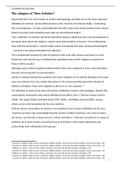COMPARATIVE RELIGION
The category of “New Animism”
Edward Burnett Tylor, the founder of modern anthropology, provided one of the most important
definitions of animism. He described animism as the "doctrine of universal vitality," contending
that it encompasses "‘an idea of pervading life and will in nature far outside modern limits, [and] a
belief in personal souls animating even what we call inanimate bodies’. 1
Tylor's definition of animism and similar definitions played a significant role in the development of
European views about the religious, cultural, and racial evolution of humans. 2 The fundamental
issue with the old animism—and the major reason it eventually lost favor among anthropologists
—was that it was always intended to be offensive. 3
This is problematic because the idea of animism in the early 20th century was based on racial
hierarchies and colonial ways of thinking that regarded Europe and its religions as superior to
those of other peoples.4
Although many of these academics believed their views were unbiased, it is now clear that these
theories had strong links to colonial politics.
Animism is being reclaimed by academics who have stripped it of its colonial ideology and in some
cases even declared it to be a viable alternative to the environmentally destructive lifestyle of
Western civilization. Many of its supporters refer to it as "new animism." 5
The definition of animism has been extensively modified by modern anthropologists. Despite this,
contemporary dictionaries still contain definitions that reflect Tylor's. 6Texts by Graham Harvey
(2006), Tim Ingold (2006), Nurit Bird-David (1999, 2006), and Phillipe Descola (2005), among
others, serve as the foundation for this new animism.
Graham Harvey's description of animism is an example of more modern definitions of the term.
“Animists are those who acknowledge that the universe is filled of humans, only some of whom
are human, and that life is always lived in contact with others”. Animism is practiced in a variety of
methods, all of which revolve around learning to treat others with respect (attentively and
productively) both individually and in groups.7
1
Joerstad, M. (2020). A Brief Account of Animism in Biblical Studies. Journal for the Study of Religion, Nature and Culture, 251
2
Joerstad, M. (2020). A Brief Account of Animism in Biblical Studies. Journal for the Study of Religion, Nature and Culture, 251
3
Wilkinson, D. (2017). Is There Such a Thing as Animism? Journal of the American Academy of Religion, 292
4
Joerstad, M. (2020). A Brief Account of Animism in Biblical Studies. Journal for the Study of Religion, Nature and Culture, 251
5
Wilkinson, D. (2017). Is There Such a Thing as Animism? Journal of the American Academy of Religion, 289
6
Joerstad, M. (2020). A Brief Account of Animism in Biblical Studies. Journal for the Study of Religion, Nature and Culture, 254
7
Joerstad, M. (2020). A Brief Account of Animism in Biblical Studies. Journal for the Study of Religion, Nature and Culture, 254
1
, COMPARATIVE RELIGION
The distinction between Tylor's interpretation of animism and the "new animism," according to
Graham Harvey, is as follows: An earlier definition of an animist was someone who could not or
did not accurately differentiate between things and people or between objects and subjects. The
new animism identifies worldviews and modes of living in which people look for guidance on how
they should interact with others in a polite and appropriate manner.8 “New animism”, in its more
symbolic and subdued version is still prevalent in many other civilizations around the world.
The working definitions of this paper will be that of Graham Harvey’s, since we will focus on the
category of ‘New Animism’. Which is used to group together religious traditions.
In general, using animism as a comparative category is both imperialist and biased against religion.
The categorization serves ideological and sociopolitical purposes rather than being neutral.
Historically the category has been linked to a variety of religious beliefs and presumptions. 9
In reality, the comeback of animism to intellectual respectability is occurring just as all of the
conventional explanations for "religious variety," which were once employed, are under greater
scrutiny than ever. The first of these is the term "religion," which is now commonly questioned for
being a Western construct that cannot be applied to "others" without raising certain (perhaps
insurmountable) epistemological problems10. The academics that created the new animism's
discursive field are interested in learning more about Indigenous ontologies and their worldview.
Scholars started to focus more intently on Indigenous cultural ideas of person and nature in an
effort to break free from projecting assumptions from contemporary Western ontology. 11 New
animism argues that Indigenous categories were essentially symbolic or metaphorical translations
of social notions, hereby maintaining their own Western ontology. 12 The idea of Indigenous
religions itself perpetuates these presumptions by demeaning the traditions of the colonized
people as being lower on a social, cultural, religious, and intellectual level.
The world religions and so-called indigenous religions are frequently compared, with the latter
serving mostly as a latent category for everything that cannot be classified as a "major tradition”.
While both world religions and indigenous religions are frequently pluralized, deeper inspection
reveals that this multiplicity is actually handled very differently. Typically, world religions are
portrayed as distinct, specialized traditions, each with its own particular historical background.
8
Joerstad, M. (2020). A Brief Account of Animism in Biblical Studies. Journal for the Study of Religion, Nature and Culture, 255
9
Paden, W. (2004). Comparison in the Study of Religion. In P. Antes, A. Geertz & R. Warne (Ed.), Volume 2 Textual, Comparative,
Sociological, and Cognitive Approaches, 78
10
Wilkinson, D. (2017). Is There Such a Thing as Animism? Journal of the American Academy of Religion, 290
11
Laack, I. (2020). The New Animism and Its Challenges to the Study of Religion. Method & Theory in the Study of Religion, 121
12
Laack, I. (2020). The New Animism and Its Challenges to the Study of Religion. Method & Theory in the Study of Religion, 120
2





